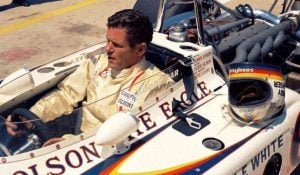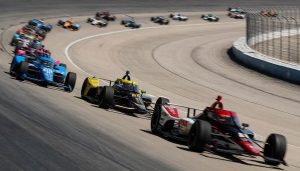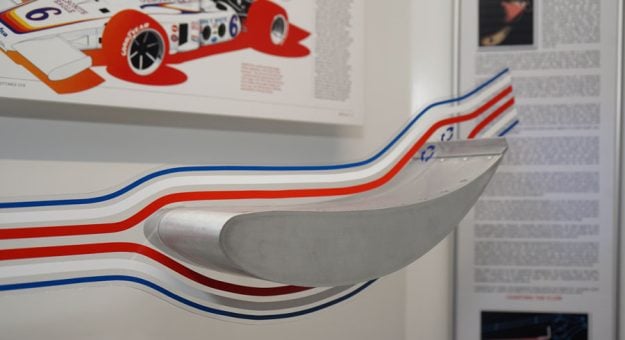It was 50 years ago when a little strip of aluminum was attached to the trailing edge of the rear wing of Bobby Unser’s Eagle Indy car at Indianapolis Motor Speedway for the 1972 Indianapolis 500. There were also small strips on each of the car’s front wings.
Attaching these strips to the front and rear of the car helped Unser break the previous year’s Indy 500 pole record by an astounding 19 mph.
Those little attachments on Unser’s Eagle were designed and developed by his legendary team owner and fellow racer Dan Gurney.
These pieces were known as the “Gurney Flap” and 50 years later, the Gurney Flap remains a key part of racing around the world. It is used on Formula 1 cars and short-track cars.
It all began during a test session at Phoenix Int’l Raceway in 1971 when Unser was testing a new design Eagle for Gurney at All American Racers.
Gurney died on Jan. 14, 2018, but his son Justin told SPEED SPORT how the Gurney Flap was born.
But first, the ground rules.
“It’s the Gurney Flap. Don’t call it a wicker bill,” said Justin Gurney, president and CEO of All American Racers. “It’s pretty cool to have an aerodynamic part named after my family.
“During the IndyCar telecasts on NBC, Townsend Bell will call it a wicker bill. I’ll send him a text and say, ‘Hey Townsend, what’s a wicker bill?’”
The idea of the Gurney Flap began at the 1967 24 Hours of Le Mans when Gurney co-drove the famed Ford Mk IV to victory with A.J. Foyt.
“It was used on the 1971 Eagle, but dad fiddled with it on the Mk IV Le Mans car in 1967,” Justin Gurney explained. “That car didn’t have a wing. It was just a spoiler on the back. That is where he started playing with that spoiler. He would change it three-eighths or a quarter inch and would totally feel the change in downforce, and it wasn’t even on a wing.
“The first time they tried it on the wing was at Phoenix in 1971.”
During a private test at the one-mile Phoenix oval Gurney, Unser and the crew were struggling to find speed.
“Bobby said something to dad like, ‘You’re the boss. Can’t you come up with something to go faster?’” Justin Gurney recalled. “Dad told Bobby about what he did at Le Mans in 1967 and how he played with the spoiler.
“He said, ‘I would move it this much and it would make all the difference down the Mulsanne Straight and into the corner. It was just a little bit. Let’s make a little spoiler and put it on the wing.’”
Unser and the crew didn’t understand what Gurney was talking about.
Gurney got some material, bent it into an L-shape and attached it to the back of the rear wing. Unser went out and drove it for a few laps and returned to the pits.

“Bobby said, ‘Something is wrong. Something is really wrong,’” Justin Gurney said. “It’s pushing everywhere. I don’t know what happened.’”
When it was pushing, the rear of the car was planted to the track surface, but it lifted the front of the car into the air.
There was a simple solution.
They put Gurney Flaps on the front wings, and after a few laps Unser through they had discovered the biggest secret in racing history.
“Bobby said, ‘We’ve got to get out of here. We have found the biggest gain ever,’” Gurney recalled.
Dan Gurney and his staff took the flap to the Lockheed Wind Tunnel. There was a rear wing in the tunnel with capillary tubes attached to the wing. Behind it was a giant wall with a monometer filled with color fluids to measure the air flow.
“You would turn on the wind tunnel, air would go over the wing and it would show you on the wall where it would be making the lift,” Justin Gurney explained. “They put the Gurney Flap on, turned it on and all of the liquid in monometer fluid shot out and hit the ceiling.
“They got goosebumps wondering what had just happened. It was a big deal. When they went to Indy with it in 1972, they were on the pole by 19 mph over the year before,” Gurney said.
Gurney and his team had discovered a huge advantage. This is where the term “wicker bill” began to be used because they didn’t want to call attention to their secret.
“Dad said we had it six months before people caught on,” Gurney recalled. “Then, the word got out real fast.
“Look at the results of the 1972 Eagle and it was extremely good. It was leading a lot of races and either broke or won. At Indy that day, he was leading by a lap before it broke.
“If you say, ‘Gurney Flap,’ people would wonder what it was,” Justin Gurney said. “They thought it was a flap. We told them we made a crappy wing and that is what we put on to stiffen it. They got away with that for a little while. Some people tried it and they put it on backward and it would be pointed the wrong way, everything wrong. That is where that came from.
“We tried to get a patent on it. Some guy from Hungary in 1931 had some similar something, so we weren’t able to patent it. We never got a penny for it.
“It’s on every race car with a wing and several airplanes and helicopters. Who knows how much that patent would have been worth?”
In addition to being a great racer and team owner, Dan Gurney was an innovator. If he had been able to patent the Gurney Flap, who knows how much money his company would be worth.
But All American Racers is doing quite well these days. Although it left racing in 2000, AAR has contracts with the defense industry and builds key parts for Elon Musk and the SpaceX Falcon 9 Rocket.
“We can’t discuss any of that,” Justin Gurney said with a smile. “It’s classified.”
Gurney’s company has 170 employees and works out of the original All American Racers buildings in Santa Ana, Calif.
But he can certainly speak on behalf of the Gurney Flap, which helped revolutionize racing.
“The original flap, you wanted the sweet spot to be within one percent of the cord of the wing,” he explained. “When we were running, we had every height all the way to one inch. I think the sweet spot was one perfect of the cord.”

For a further explanation of the Gurney Flap and how it works, Craig Hampson is one of the leading and brightest engineers in the NTT IndyCar Series. He was the engineer when Sebastien Bourdais won his four straight Champ Car Series titles with Newman-Haas-Lanigan Racing from 2004-2007.
Hampson later worked at Andretti Autosport and was the engineer for Kurt Busch’s Indianapolis 500 effort in 2014. In 2017, he joined Dale Coyne Racing and was reunited with Bourdais.
Today, Hampson is the director of trackside engineering for Arrow McLaren SP, which fields two cars in the IndyCar Series.
“The Gurney Flap is simply a 90-degree, L-shaped piece of material that goes on the trailing edge of the high-pressure side of a wing on a race car,” Hampson explained. “It is effectively like a flap that would be on that area of the wing, but not a separate piece. It is a very basic looking extension.
“It increases the pressure differential between the high-pressure side and the low-pressure side. It tricks the wing into thinking it is larger than it otherwise is and adds to the downforce that the wing makes.
“The beauty of it is that it can be made with $8 worth of material and in 10 minutes to adjust the downforce the wing makes rather than go through all of the trouble of making complete new wing parts,” Hampson said. “Back in the day when that was invented, wings were made of formed metal ribs and metal skin and riveted together. They were beautiful works of art but took a huge amount of effort to make. Something that quickly modified performance was a huge deal.”
Teams used to design and develop their own Gurney Flaps, but IndyCar has made it a spec part that is manufactured by Dallara and available to all teams.
“Why do they say you have to use the existing Dallara parts and why can you not vary the height and the shape? It’s because they are trying to save the teams and the manufacturers from themselves,” Hampson explained. “If you make big ones and short ones and tapering ones, Honda and Chevrolet would spend copious amounts of wind-tunnel time trying different pieces.
“It does feel a little ridiculous to be spending tens of thousands of dollars evolving a little 90-degree piece of aluminum or carbon fiber, but if there are very few things you can change, the teams and manufacturers with more resources will spend huge amounts of money changing what they are allowed to change.
“IndyCar has decided they are going to stomp that out and save everybody from themselves, so they don’t go hog-wild inventing an infinite number of wickers.”
Today’s Gurney Flaps are bolted onto the wings in the high-pressure area, the trailing edge. In the past, rules allowed teams to change Gurney Flaps during a race.
“There was a slot in the trialing edge of the wing and that L-shaped piece would slide in through the side through a little door in the endplate,” Hampson said. “That gave you the ability during a pit stop to slide out the existing wicker and put a bigger or smaller one in to actually change the downforce or drag during a race or do it very quickly in practice. We don’t have those anymore.
“These days, the way the Gurney Flap is changed on an Indy car, there is a screw thread adjuster at the base of the wings.”
The Gurney Flap has even found a place in popular American culture. The Chevrolet Corvette catalog includes a Gurney Flap that can be added to improve the downforce of the iconic street car.
